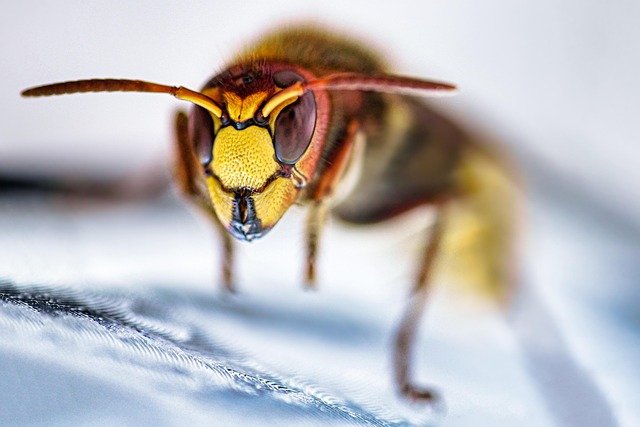Wasps, often seen as nuisances, play a vital role in our ecosystem. For effective and safe residential wasp treatment, professionals recommend understanding wasp behaviors and using non-toxic repellents, physical barriers, and eco-friendly methods like microbial controls and light-based deterrents, avoiding hazardous chemicals. Natural prevention strategies such as habitat manipulation, cleaning, introducing natural predators, and planting wasp-repelling herbs also offer sustainable residential wasp treatment options that protect both human health and the environment.
In many regions, wasps are a nuisance, yet their ecological role is vital. This article explores innovative techniques for managing wasp populations safely, focusing on both residential and natural prevention strategies. We delve into the behavior and habitat of wasps, comparing traditional to modern residential wasp treatment methods. Additionally, we highlight eco-friendly solutions that minimize environmental impact while controlling wasp populations effectively. By understanding these advanced approaches, folks can foster a harmonious coexistence with these beneficial insects.
Understanding Wasps: Behavior and Habitat
Wasps, often overlooked as mere nuisances, play a significant role in our ecosystem. Understanding their behavior and habitat is crucial for effective and safe management. These insects are highly adaptive, with complex social structures, particularly in colonies. They primarily inhabit areas with abundant food sources, such as gardens, forests, or nearby water bodies, building nests in trees, bushes, or even cavities in buildings.
Residential wasp treatment requires a nuanced approach due to their presence in diverse urban environments. Their behavior varies; some species are aggressive and territorial, while others prefer to avoid human contact. By studying these habits, professionals can employ targeted strategies for population control. This includes identifying nesting sites, using non-toxic repellents, or implementing physical barriers, ensuring a safe and efficient residential wasp treatment method.
Traditional vs. Innovative Residential Wasp Treatment Methods
In the past, residential wasp treatments largely relied on traditional methods such as chemical sprays and traps. While effective, these approaches often come with drawbacks like environmental impact, potential health risks for residents, and the possibility of wasps developing resistance over time. Innovative techniques, however, are transforming how we manage wasp populations safely.
Today, advanced methods include targeted microbial controls that harness natural predators, such as parasitoid wasps, to eliminate specific species. Additionally, innovative residential wasp treatments employ heat or cold therapy, light-based repellents, and even ultrasonic devices that emit sounds wasps find unpleasant. These modern approaches prioritize safety for both humans and the environment while offering more sustainable solutions to wasp infestations.
Safe and Eco-Friendly Solutions for Wasp Control
Wasp populations can be managed safely and sustainably through eco-friendly solutions, ensuring both human safety and environmental preservation. In residential areas, traditional pest control methods often involve hazardous chemicals that can have detrimental effects on non-target species, including beneficial insects and local wildlife. As a result, many professionals now advocate for integrated pest management (IPM) strategies that offer safer alternatives for wasp control.
One such approach is the use of biological controls, such as introducing natural predators or parasites that target specific wasp species. For example, parasitoid wasps themselves can be released to lay eggs within the nests of problem species, effectively breaking their life cycle. Additionally, there are natural repellents and deterrents derived from plants that can repel wasps without causing harm. These methods not only provide effective residential wasp treatment but also contribute to a more balanced ecosystem by minimizing the reliance on synthetic pesticides.
Prevention Strategies: Reducing Wasp Populations Naturally
Wasp populations can be managed safely and effectively through a combination of natural prevention strategies, ideal for those seeking a more eco-friendly residential wasp treatment. One key approach is habitat manipulation; wasps are attracted to certain foods, so removing potential food sources like fruit or sweet substances from outdoor spaces can significantly deter them. Regular cleaning and maintenance of areas where food is stored or prepared is crucial.
Additionally, introducing natural predators such as birds and beneficial insects like ladybugs can help control wasp numbers. Planting specific herbs and flowers that repel wasps around residential properties has also shown promise. These natural methods not only reduce wasp populations but also avoid the potential risks associated with chemical insecticides, making them attractive options for those prioritizing safety in residential wasp treatment.
In conclusion, managing wasp populations safely requires a combination of understanding their behavior, exploring innovative treatment methods, and adopting eco-friendly solutions. By integrating natural prevention strategies into our approach, we can reduce wasp infestations while minimizing environmental impact. For effective residential wasp treatment, these modern techniques offer safer alternatives to traditional methods, ensuring a more harmonious coexistence with these often maligned insects.
